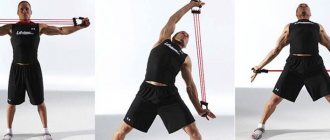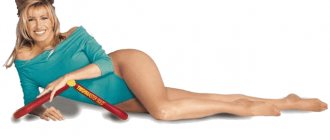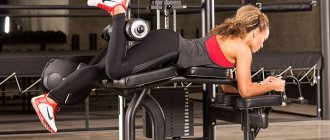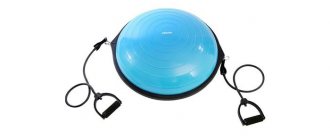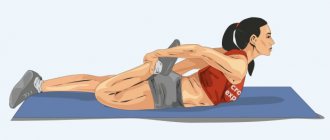What is a rubber band?
A rubber band is a universal tubular expander with handles that make it easier to hold the projectile. Thanks to this distinctive feature, a wide variety of exercises is available.
This apparatus is often used instead of the most common simulators. Throw the tourniquet over a stable object and perform various types of rows that will help strengthen your back muscles.
The expander is also ideal for developing the deltoid, biceps (biceps) and triceps (triceps) muscles of the arms. To do this, it is enough to secure the tourniquet under the foot and perform alternate lifting in front of you with each hand, abduction, flexion and extension at the elbow joints. You can find out more about the exercises below.
Why should you get a rubber band?
As mentioned above, a rubber expander can be both a replacement for the gym and an addition to it. When purchasing a projectile, decide for what purpose you are purchasing it.
If you want to tone your muscles, lose weight, and create beautiful body shapes, then a rubber expander is just the thing for this. In addition, a smooth tension of the tourniquet will allow you to safely conduct a workout, which is very important on the path of body development.
Rubber expanders, just like rubber loops, differ from each other in color. Each color indicates the corresponding degree of tension:
- Yellow – light load, suitable for beginners.
- Green – medium load, can be used confidently in most exercises. If this is easy for you, then move on to the next one.
- The red expander gives a large load and is suitable for trained men and women.
- Blue is the latest tourniquet in terms of tension; with its help, only advanced fitness enthusiasts will be able to perform exercises technically.
Some manufacturers produce black tourniquets for high-level athletes.
Precautionary measures
Before class, be sure to warm up your body with cardio exercises and warm up all your joints and muscles.
Training with a rubber band, as with any other equipment, must be accompanied by technically correct execution of the exercise. To do this, carefully study the movement technique, try to do several repetitions without weights. And only after that start a full workout.
Before performing the exercise, inspect the expander for tears or abrasions. If any defect is found, it is recommended to replace the harness. Otherwise, when performing the movement, the rubber expander may rupture and injure you.
Contraindications
Training with a rubber band, just like engaging in any other active activity, should improve health indicators and not harm the body. Therefore, you should familiarize yourself with a number of contraindications:
- deviations from the cardiovascular system;
- spinal instability;
- diseases of the respiratory system, kidneys in the acute stage;
- postoperative period;
- rheumatism, diseases of the digestive tract, gall bladder, liver;
- prolapse of internal organs, bending of the uterus, hernia of any location, malignant tumors of the pelvic organs;
- musculoskeletal injuries.
If in doubt, consult your doctor.
Rubber band for learning pull-ups
Pull-ups are one of the basic exercises that have been taught since school. If you think that only men should be able to do pull-ups, you are deeply mistaken.
This gymnastic element determines the overall physical fitness of the body and is an alternative to many gym exercises. When performing it, the trapezius, latissimus, deltoid, biceps (biceps) and triceps (triceps) muscles develop.
The stabilizing muscle groups of the upper body, including the rectus abdominis, are also not ignored.
Do you want your arms to look beautiful and toned, and your posture to be impeccable? Then quickly buy a rubber expander and start training!
- Attach the handles of the expander to the edges of the crossbar.
- Stand on any hill. Take the horizontal bar with a normal grip, shoulder-width apart, and stand with your feet on the tourniquet so that it hangs underneath you.
- Bend your elbows, trying to touch your chest to the bar. And return back to the starting position.
- Perform 3 sets of 5-10 repetitions per workout. Try to add 1 pull-up every week. Once you can easily do 10 pull-ups with a rubber band, try doing pull-ups on your own.
Even if you are in good physical shape, training with a rubber expander will allow you to increase the number of pull-ups.
How to achieve this? It's simple: at the moment when you have completed the maximum number of repetitions using your own efforts, use a rubber band and pull yourself up a few more times.
Advantages
Practice shows that the less sophisticated a thing is, the more useful it is. It’s the same with a burn: it won’t be able to harm you, but it will give you a lot of bonuses:
- It will help to work usually inactive muscles, as well as to work specific muscle groups in isolation.
- It will give an increasing load: the more you pull it, the more force you need to apply (unlike iron).
- Allows you to vary the load: elastic bands of different elasticity will simplify or complicate ordinary exercises (for example, lifting a barbell or pull-ups).
- Thanks to its small dimensions, it is easy to take it with you anywhere: even to the country house, even to the ocean. And training with a tape does not require a lot of space.
- And, of course, accessibility: the stores have plenty to choose from for every color and budget.
Training program (set of exercises)
Start working on yourself with three training sessions a week. Try to choose days so that the rest between them is approximately the same.
Perform each exercise in 3 approaches, rest between sets for 1-1.5 minutes. The number of repetitions is individual for each exercise and is indicated in parentheses.
A set of exercises for women
DAY 1
Perform each exercise in 2-3 approaches, rest between approaches for 1-1.5 minutes. The number of repetitions is individual for each exercise and is indicated in parentheses.
- Raising your arm in front of you using an expander (12 times)
- Abduction of the arm to the side using an expander (12 times)
- Pulling the leg back on all fours using an expander (20 times)
- “Swimmer” with an expander (25 times)
DAY 2
Perform each exercise in 2-3 approaches, rest between approaches for 1-1.5 minutes.
- Standing press using an expander (15 times)
- Bent-over abdominal row using an expander (15 times)
- Chest rows with expander (12 times)
- Squats with expander (25 times)
- Raising the torso on an inclined bench (Sitap) with an expander (15 times)
DAY 3
Perform each exercise in 2-3 approaches, rest between approaches for 1-1.5 minutes.
- External rotation of the shoulder using an expander (25 times)
- Horizontal row using an expander (15 times)
- Taking the leg back while standing using an expander (25 times)
- Squats with expander (20 times)
- “Swimmer” with an expander (20 times)
We recommend watching additional exercises for women in the following video.
A set of exercises for men
DAY 1
Perform 3-4 sets with 45-60 seconds rest in between.
- Standing press using an expander (15 times)
- Reduction of arms using an expander (15 times)
- Squats with expander (20 times)
- Raising the torso on an inclined bench (Sitap) with an expander (15 times)
DAY 2
Perform 3-4 sets with a rest of 45-60 seconds.
- Chest rows with expander (20 times)
- Bench press with expander (15 times)
- External rotation of the shoulder using an expander (20 times)
- Raising the torso on an inclined bench (Sitap) with an expander (15 times)
- “Swimmer” with an expander (25 times)
DAY 3
- Bent-over abdominal rows using an expander (20 times)
- Raising your arm in front of you using an expander (15 times)
- Abduction of the arm to the side using an expander (15 times)
- Reduction of arms using an expander (20 times)
- “Swimmer” with an expander (30 times)
We recommend watching additional exercises and complexes for men in the following videos.
Elements of training with a wrestling harness, which is largely similar in characteristics to a rubber expander (tourniquet), will help diversify your training.
And a specialized complex on hand.
Features of training with a tourniquet
Exercises with a rubber band only work if they are applied to the correct training system. We will create this system now.
For the fastest progress in training with a tourniquet, you need to:
- Follow the principle of load progression. Increase objective training stress: resistance of the band, number of approaches, repetitions, exercises;
- Do this in the supercompensation phase - the only stage that is optimal for gaining muscle mass;
- Progress gradually, do not try to do everything “in a rush.” The main problem that beginners face in the first stages of training with rubber is overtraining. In 2-3 weeks the body wears out so much that further work becomes impossible;
- Set personal goals and move based on your understanding of the task. With rubber loops you can achieve any goals: from gaining muscle mass and losing weight, to developing strength, endurance, and explosive speed.
Load progression and supercompensation
Compliance with the principle of progression of loads in the supercompensation phase is the main secret to obtaining the desired result. Thanks to the combination of these two principles, you can train with a tourniquet more effectively than in the gym.
The training process is divided into 4 stages:
- Traumatization. Happens during training. Muscles and all body systems are subject to stress, which is necessary to trigger the following phases;
- Recovery. Starts after completion of training. During the recovery period, the athlete's body is ready to perform worse than before training. After completion of the phase, there is a return to the pre-training level;
- Supercompensation. The body has coped with stress and is ready to perform the usual load with less energy. But we do not repeat the load, but follow the principle of progression of loads and increase it. Objective stress increases while subjective sensations remain at the same level;
- Loss of super compensation. Occurs when an athlete trains too infrequently and misses the supercompensation phase:
Using the example of squats with a rubber band, workouts might look like this
Week #1
Monday. Training
| Exercise | Rubber color (resistance) | Approaches | Repetitions | Rest in minutes after approach |
| Squats with loops | Purple (12-36) | 3 | 20 | 2 |
Tuesday. Recovery. You cannot train your lower body (the muscles that were used during training).
Wednesday. The recovery continues.
Thursday. Supercompensation sets in. It lasts from Thursday to Saturday. During this period, you need to train your legs again. Let's do a workout today:
| Exercise | Rubber color (resistance) | Approaches | Repetitions | Rest in minutes after approach |
| Squats with loops | Purple (12-36) | 4 | 20 | 2 |
We follow the principle of progression of loads, adding 1 approach.
Friday. Recovery. You can only train muscles that were not used in the previous lesson.
Saturday. The recovery continues.
Sunday. Supercompensation. We follow the principle of load progression by adding a new approach.
| Exercise | Rubber color (resistance) | Approaches | Repetitions | Rest in minutes after approach |
| Squats with loops | Purple (12-36) | 5 | 20 | 2 |
Week #2
Monday. Recovery. Let's relax
Tuesday. Recovery continues along with rest.
Wednesday. The recovery is over, but supercompensation has not yet arrived. We rest for another day.
Thursday. Supercompensation. We train our legs. Let's add one approach again.
| Exercise | Rubber color (resistance) | Approaches | Repetitions | Rest in minutes after approach |
| Squats with loops | Purple (12-36) | 6 | 20 | 2 |
Friday. Recovery.
Saturday. We continue to rest.
Sunday. Supercompensation. We change the harness to rubber with greater resistance, and reduce the number of approaches.
| Exercise | Rubber color (resistance) | Approaches | Repetitions | Rest in minutes after approach |
| Squats with loops | Green (17-54) | 3 | 20 | 2 |
Week #3
Monday, Tuesday – recovery.
Wednesday. Supercompensation. We increase the load by adding one set and reducing the rest by 30 seconds.
| Exercise | Rubber color (resistance) | Approaches | Repetitions | Rest in minutes after approach |
| Squats with loops | Green (17-54) | 4 | 20 | 1,5 |
Thursday, Friday, Saturday – rest. The body recovers after exercise.
Sunday. Supercompensation. Add 1 approach.
| Exercise | Rubber color (resistance) | Approaches | Repetitions | Rest in minutes after approach |
| Squats with loops | Green (17-54) | 5 | 20 | 1,5 |
Week #4
Monday, Tuesday – we recover after class.
Wednesday. Supercompensation. Let's add the approach again.
| Exercise | Rubber color (resistance) | Approaches | Repetitions | Rest in minutes after approach |
| Squats with loops | Green (17-54) | 6 | 20 | 1,5 |
Thursday, Friday – recovery.
Saturday. Supercompensation. We change the tires to harder ones with a decrease in the number of approaches.
| Exercise | Rubber color (resistance) | Approaches | Repetitions | Rest in minutes after approach |
| Squats with loops | Blue (23-68) | 3 | 20 | 1,5 |
Sunday. Recovery.
Result: in 4 weeks we significantly increased the resistance of the rubber and decreased rest, which affected strength endurance and the appearance of the lower body. We continue to use this system until we are completely satisfied with the result.
Graduation and training goals
To achieve results, you need to know your goals and go in their direction. The main goals when training with rubber look like this:
- Development of performance
. High performance leads to increased muscle mass. Trains in the range of 6-15 repetitions, in 3-7 approaches with a rest of 1-2 minutes. The progression of loads is maintained by alternating an increase in rubber resistance with an increase in the number of approaches; - Development of endurance
. It also allows you to lose weight and burn fat. Endurance development is an increased duration of training in the range of 15-25 repetitions in 3-7 approaches, with a large number of exercises. The harness resistance is minimal. Otherwise, it will not be possible to complete a high volume of work. Rest between sets – 30-60 seconds. To strength work with rubber, you can add aerobic training in the form of running or jumping rope; - Strength training
. Development of strength qualities, which will help prepare for working with a barbell and other equipment found in powerlifting and extreme strength sports. Building strength will help beginner ectomorphs who want to build muscle mass from scratch. We train in the range of 1-6 repetitions with high resistance rubber. We perform from 2 to 5 approaches with a rest of 2-4 minutes. Before performing heavy approaches, warming up is mandatory.
Progression of loads during the period of supercompensation within the framework of understanding your goal is the key to success.
Understanding that we have everything to implement the task, and all that remains is to start moving in a given direction, leads us to the last mistake - moving forward too quickly.
You need to start with a load that is comfortable for you at the moment. After the first workout, you should feel slightly tired instead of wanting to die. You need to progress gradually, step by step. Otherwise, the level of cortisol (the main stress hormone) rises sharply, and physical and mental emasculation occurs. Progress stops completely.
The expression “The slower you go, the further you will go” is most relevant in relation to this situation.
